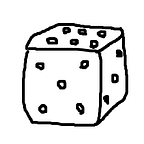Effective HP versus: XdY
Previous: Effective HP versus: 1d20
It’s well-known that as you sum dice together that you start to get a bell curve shape (normal distribution). For standard dice this happens quite quickly; even three d6s are enough to start approximating this shape (program #1 on AnyDice). How does this affect effective hit points compared to a single die (uniform distribution)?
1d20 vs. 5d12–22
Matching the medians
I picked 5d12–22 because it behaves similarly to 1d20 around the median. Here’s what I mean when I say the medians are similar:
Both graphs look about the same near the 50%¹ mark of the “At Least” graph, i.e. the tail distribution. This means that near the median, each point of modifier has about the same worth in both systems. We can match the position of the median by adding a flat modifier, and all of our distributions have at least one parameter that we can adjust to match the slope. In the case of a uniform distribution, we can adjust the die size; in the case of XdY we can also adjust the number of dice. Increasing these makes the slope shallower, while decreasing them makes the slope steeper.
The effect on EHP
Since EHP is the reciprocal of the “At Least” graph, i.e. the tail distribution, this means the two curves look similar around the median in the EHP graph as well. However, the EHP shows a difference in the right tail, where the problem was.
We can see that the bell curve slows down the hard takeoff in effective hit points; now it takes a 24 needed to hit before the EHP reaches the same as needing a 20 on a d20.
Of course, 5d12 is not very practical for a core mechanic; five dice is a lot to be adding together on the regular.
3d6 vs. 1d8+6
For something more practical, let’s compare the famous 3d6 to a single die that has a similar EHP graph outside the right tail: 1d8+6. Similar to before, the +6 is to put the medians in the same place. AnyDice.
For the most part this is just a lower-precision version of the previous graph. By precision, I mean the scale of the x-axis: 1 point of AC or attack modifier in this graph is worth about 2.5 points in the previous graph. We shouldn’t be surprised — any two normal distributions are just shifted and scaled versions of each other, as are any two uniform distributions. While we can’t get a perfect normal distribution by summing a finite number of dice, even three gets us close enough for most practical purposes. If you want more precision than 3d6 but the same overall shape, I’d go with 3d10 or an opposed 2d10, which keeps all the individual dice to single digits.
Opposed rolls
An opposed roll is where two sides roll dice and the higher total wins.
While positive dice don’t cancel out negative dice — 1d20–1d20 is not zero — what you can do is trade -1dX for 1dX-(X+1). This means that an opposed 1d20 vs. 1d20 is equal to 2d20 vs. 21, and in fact, for any opposed roll system with standard dice, there is an equivalent system where one side rolls all the dice. So for XdY, opposed rolls push things more towards a bell curve.
How fast is the growth in EHP for a normal distribution?
The tail distribution falls approximately² as exp(-x²), so therefore the EHP in the right tail grows approximately as exp(x²) (up to some scaling). That’s better than suddenly spiking to infinity as with a uniform distribution, but it’s still pretty severe.
Can we slow the growth of EHP in the right tail even more while keeping the rest of the graph about the same? Yes, but we’ll need another type of distribution. Next time, we’ll talk about exploding dice.
Series index
[1] Note that we don’t have to use 50% specifically. The idea is to pick a chance of success that we expect our system to be operating near most of the time, and match the graphs near there. For example, if you instead expect a typical chance of success to be 60% instead, you could match the graphs a little higher up. However, for demonstration purposes we’ll stick to 50%.
[2] Practically, we will be rolling a very finite number of standard dice, so their sum will result in faster EHP growth in the tail compared to an ideal normal distribution. The important thing is that the EHP growth is less extreme than a single die, but more extreme than an exploding die.
